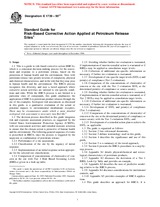Potrebujeme váš súhlas na využitie jednotlivých dát, aby sa vám okrem iného mohli ukazovať informácie týkajúce sa vašich záujmov. Súhlas udelíte kliknutím na tlačidlo „OK“.
ASTM E1739-95e1
Standard Guide for Risk-Based Corrective Action Applied at Petroleum Release Sites (Includes all amendments And changes 8/16/2017).
Automaticky preložený názov:
Štandardné príručka pre Risk - Based Nápravné opatrenia uplatňovaných na ropných verziu weby
NORMA vydaná dňa 1.1.1995
Informácie o norme:
Označenie normy: ASTM E1739-95e1
Poznámka: NEPLATNÁ
Dátum vydania normy: 1.1.1995
Kód tovaru: NS-42839
Počet strán: 52
Približná hmotnosť: 156 g (0.34 libier)
Krajina: Americká technická norma
Kategória: Technické normy ASTM
Anotácia textu normy ASTM E1739-95e1 :
Keywords:
Contamination-environmental, Corrective action, Petroleum/petroleum products, Qualitative chemical spot test, RBCA process, Risk analysis-environmental, Subservice contamination, risk-based corrective action (RBCA)-applied at petroleum release sites, Environmental control/fate, risk-based corrective action (RBCA)-appliedat petroleum release sites, Petroleum release sites
Doplňujúce informácie
| 1. Scope | ||||
|
1.1 This is a guide to risk-based corrective action (RBCA), which is a consistent decision-making process for the assessment and response to a petroleum release, based on the protection of human health and the environment. Sites with petroleum release vary greatly in terms of complexity, physical and chemical characteristics, and in the risk that they may pose to human health and the environment. The RBCA process recognizes this diversity, and uses a tiered approach where corrective action activities are tailored to site-specific conditions and risks. While the RBCA process is not limited to a particular class of compounds, this guide emphasizes the application of RBCA to petroleum product releases through the use of the examples. Ecological risk assessment, as discussed in this guide, is a qualitative evaluation of the actual or potential impacts to environmental (nonhuman) receptors. There may be circumstances under which a more detailed ecological risk assessment is necessary (see Ref (1). 1.2 The decision process described in this guide integrates risk and exposure assessment practices, as suggested by the United States Environmental Protection Agency (USEPA), with site assessment activities and remedial measure selection to ensure that the chosen action is protective of human health and the environment. The following general sequence of events is prescribed in RBCA, once the process is triggered by the suspicion or confirmation of petroleum release: 1.2.1 Performance of a site assessment; 1.2.2 Classification of the site by the urgency of initial response; 1.2.3 Implementation of an initial response action appropriate for the selected site classification; 1.2.4 Comparison of concentrations of chemical(s) of concern at the site with Tier 1 Risk Based Screening Levels (RBSLs) given in a look-up table; 1.2.5 Deciding whether further tier evaluation is warranted, if implementation of interim remedial action is warranted or if RBSLs may be applied as remediation target levels; 1.2.6 Collection of additional site-specific information as necessary, if further tier evaluation is warranted; 1.2.7 Development of site-specific target levels (SSTLs) and point(s) of compliance (Tier 2 evaluation); 1.2.8 Comparison of the concentrations of chemical(s) of concern at the site with the Tier 2 evaluation SSTL at the determined point(s) of compliance or source area(s); 1.2.9 Deciding whether further tier evaluation is warranted, if implementation of interim remedial action is warranted, or if Tier 2 SSTLs may be applied as remediation target levels; 1.2.10 Collection of additional site-specific information as necessary, if further tier evaluation is warranted; 1.2.11 Development of SSTL and point(s) of compliance (Tier 3 evaluation); 1.2.12 Comparison of the concentrations of chemical(s) of concern at the site at the determined point(s) of compliance or source area(s) with the Tier 3 evaluation SSTL; and 1.2.13 Development of a remedial action plan to achieve the SSTL, as applicable. 1.3 The guide is organized as follows: 1.3.1 Section 2 lists referenced documents, 1.3.2 Section 3 defines terminology used in this guide, 1.3.3 Section 4 describes the significance and use of this guide, 1.3.4 Section 5 is a summary of the tiered approach, 1.3.5 Section 6 presents the RBCA procedures in a step-by-step process, 1.3.6 Appendix X1 details physical/chemical and toxicological characteristics of petroleum products, 1.3.7 Appendix X2 discusses the derivation of a Tier 1 RBSL Look-Up Table and provides an example, 1.3.8 Appendix X3 describes the uses of predictive modeling relative to the RBCA process, 1.3.9 Appendix X4 discusses considerations for institutional controls, and 1.3.10 Appendix X5 provides examples of RBCA applications. 1.4 This guide describes an approach for RBCA. It is intended to compliment but not supersede federal, state, and local regulations. Federal, state, or local agency approval may be required to implement the processes outlined in this guide. 1.5 The values stated in either inch-pound or SI units are to be regarded as the standard. The values given in parentheses are for information only. 1.6 This standard does not purport to address all of the safety concerns, if any, associated with its use. It is the responsibility of the user of this standard to establish appropriate safety and health practices and determine the applicability of regulatory limitations prior to use. |
||||
| 2. Referenced Documents | ||||
|




 Cookies
Cookies
